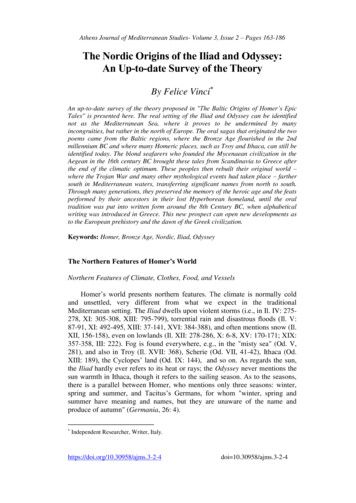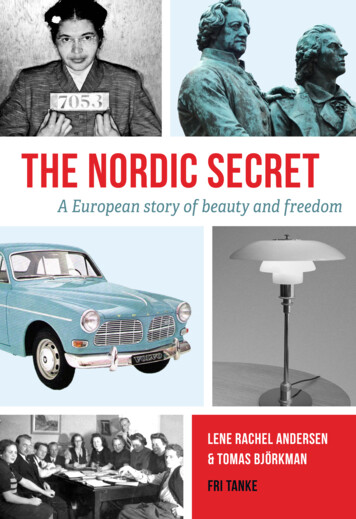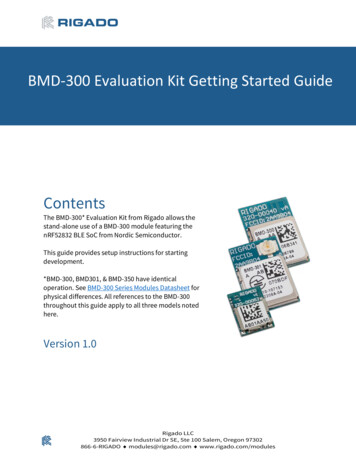
Transcription
Athens Journal of Mediterranean Studies- Volume 3, Issue 2 – Pages 163-186The Nordic Origins of the Iliad and Odyssey:An Up-to-date Survey of the TheoryBy Felice Vinci An up-to-date survey of the theory proposed in "The Baltic Origins of Homer’s EpicTales" is presented here. The real setting of the Iliad and Odyssey can be identifiednot as the Mediterranean Sea, where it proves to be undermined by manyincongruities, but rather in the north of Europe. The oral sagas that originated the twopoems came from the Baltic regions, where the Bronze Age flourished in the 2ndmillennium BC and where many Homeric places, such as Troy and Ithaca, can still beidentified today. The blond seafarers who founded the Mycenaean civilization in theAegean in the 16th century BC brought these tales from Scandinavia to Greece afterthe end of the climatic optimum. These peoples then rebuilt their original world –where the Trojan War and many other mythological events had taken place – farthersouth in Mediterranean waters, transferring significant names from north to south.Through many generations, they preserved the memory of the heroic age and the featsperformed by their ancestors in their lost Hyperborean homeland, until the oraltradition was put into written form around the 8th Century BC, when alphabeticalwriting was introduced in Greece. This new prospect can open new developments asto the European prehistory and the dawn of the Greek civilization.Keywords: Homer, Bronze Age, Nordic, Iliad, OdysseyThe Northern Features of Homer’s WorldNorthern Features of Climate, Clothes, Food, and VesselsHomer’s world presents northern features. The climate is normally coldand unsettled, very different from what we expect in the traditionalMediterranean setting. The Iliad dwells upon violent storms (i.e., in Il. IV: 275278, XI: 305-308, XIII: 795-799), torrential rain and disastrous floods (Il. V:87-91, XI: 492-495, XIII: 37-141, XVI: 384-388), and often mentions snow (Il.XII, 156-158), even on lowlands (Il. XII: 278-286, X: 6-8, XV: 170-171; XIX:357-358, III: 222). Fog is found everywhere, e.g., in the "misty sea" (Od. V,281), and also in Troy (Il. XVII: 368), Scherie (Od. VII, 41-42), Ithaca (Od.XIII: 189), the Cyclopes’ land (Od. IX: 144), and so on. As regards the sun,the Iliad hardly ever refers to its heat or rays; the Odyssey never mentions thesun warmth in Ithaca, though it refers to the sailing season. As to the seasons,there is a parallel between Homer, who mentions only three seasons: winter,spring and summer, and Tacitus’s Germans, for whom "winter, spring andsummer have meaning and names, but they are unaware of the name andproduce of autumn" (Germania, 26: 4). Independent Researcher, Writer, Italy.https://doi.org/10.30958/ajms.3-2-4doi 10.30958/ajms.3-2-4
Vol. 3, No. 2Vinci: The Nordic Origins of the Iliad and Odyssey.Clothes described in the two poems are consistent with a northern climateand the finds of the Nordic Bronze age. In the episode of the Odyssey in whichTelemachus and Peisistratus are guests at Menelaus’s house in Sparta, the twoyoung men get ready for lunch after a bath: "They wore thick cloaks andtunics" (Od. IV: 50–51). The same is said of Odysseus when he is a guest atAlcinous’s house (Od. VIII: 455-457). Similarly, Nestor’s cloak is "double andlarge; a thick fur stuck out" (Il. X: 134) and, when Achilles leaves for Troy, hismother thoughtfully prepares him a trunk "filled with tunics, wind-proof thickcloaks and blankets" (Il. XVI: 223-224). Those "thick cloaks and tunics" can becompared to the clothes of a man found in a Danish Bronze Age tomb: "Thewoolen tunic comes down to the knees and a belt ties it at the waist. He alsowears a cloak, which a bronze buckle pins on his shoulder" (Bibby 1966: 245).Also Odysseus wears "a golden buckle" (Od. XIX: 226) on his cloak, and "ashining tunic around his body like the peel on a dry onion" (Od. XIX: 232233); all of this fit what Tacitus says of Germanic clothes: "The suit foreveryone is a cape with a buckle ( ) The richest are distinguished by a suit(.) which is close-fitting and tight around each limb" (Germania 17: 1).Regarding food, it’s remarkable that fruit, vegetables, olive oil, olives, figsnever appear on the table of Homer’s heroes. Their diet was based on meat(beef, pork, goat, and game), much like that of the Vikings, who "ate meat inlarge quantities, so much so that they seemed to regard the pleasure of eatingmeat as one of the joys of life" (Pörtner 1996: 207). Homer’s characters had ahearty meal in the morning: "In the hut Odysseus and his faithful swineherd litthe fire and prepared a meal at sunrise" (Od. XVI: 1–2), like Tacitus’sGermans: "As soon as they wake up ( ) they eat; everyone has his own chairand table" (Germania 22: 1). This individual table (trapeza) is typical of theHomeric world, too (Od. I: 138).One should also note that, while pottery tableware was prevalent inGreece, the Nordic world was marked by "a stable and highly advanced bronzefounding industry" (Fischer-Fabian 1985: 90), which squares with Homer’spoems, which mention only vessels made of metal: "A maid came to pourwater from a beautiful golden jug into a silver basin" (Od. I, 136-137); winewas poured "into gold goblets" (III: 472) and "gold glasses" (I: 142). When avessel felt to the ground in Odysseus’ palace, instead of breaking it "boomed"(bombēse, Od. XVIII: 397). Also lamps (XIX: 34), cruets (VI: 79), and urns (Il.XXIII: 253) were made of gold. As to the poor, Eumaeus the herdsman pourswine for his guests "into a wooden cup" (kissybion, Od. XVI: 52), like the cupOdysseus gives Polyphemus (Od. IX: 346). Wood, of course, is the cheapestmaterial in the north (Estonia and Latvia have an ancient tradition of woodenbeer tankards).164
Athens Journal of Mediterranean StudiesApril 2017Nordic Customs and Archaism of Homer’s WorldThere are many remarkable parallels between the Homeric Achaeans andthe Nordic world, in the fields of their social relations, interests, lifestyles, andso on, despite the time gap. E.g., Homer’s habit of giving things and slaves avalue in "oxen" – a new vase, decorated with flowers, was worth "the price ofan ox" (Il. XXIII, 885); a big tripod was worth twelve oxen (Il. XXIII: 703);Ulysses’ nurse Eurycleia had cost twenty oxen (Od. I: 431), and so on – iscomparable to the fact that, during the first Viking Age, cows were still used"as the current monetary unit" (Pörtner 1996: 199). A statement from Tacitusbridges these two distant epochs: "Cattle and oxen (.) are the Germans’ onlyand highly valued wealth" (Germania, 5, 1). Besides, the prominence of oxenin the economy of the Homeric world is another argument in favour of theNordic setting, while in the Greek world other kinds of livestock are moreimportant (one should also consider how important were beef and pork inAchaeans’ diet).Still on Tacitus, Karol Modzelewski, by quoting a custom reported inGermania, 11, writes: "The mention of assembly decisions taken by a peculiaracclamation method, consisting in brandishing spears, is confirmed by thecodifications, dating back to the 12th century, of the Norwegian juridicaltraditions, where this rite is called vapnaták" (Modzelewski 2008: 33). It isremarkable that the custom of going armed with spear to the assembly is foundin Homer: Telemachus "went to the assembly, he held the bronze spear" (Od.II: 10). Thus a custom dating back to the Homeric world was still present inViking Norway of the 12th century.One should also note that Odysseus’ ship had a removable mast, a featuretypical of all Homeric vessels: both the Iliad (I: 434, 480) and Odyssey (II: 424,VIII: 52) confirm that setting up and taking down the mast were customary atthe beginning and the end of each mission. This feature was also typical of theViking ships, which lowered the mast whenever there was the risk of suddengusts or ice formation, which could cause the ship to capsize. Anotherstructural feature typical of Viking ships, the flat keel, is found also in Homericones, as one can infer from the passage narrating Ulysses’ arrival in Ithaca,where the Phaeacian ship "mounted the beach by half the length" (Od. XIII:114).Another peculiar custom of the Homeric heroes is that they got off thechariots and left them aside during the duels: e.g., the Trojan hero Asius usedto fight "on foot in front of his puffing horses, which the charioteer kept all thetime behind him" (Il. XIII: 385–386). Scholars agree that this way of using thechariots seems to be absurd and senseless: "No one has ever fought like theheroes of Homer. They are led to battle in chariot, then they jump off to fightagainst the enemy. All that we know about the battle chariots in EasternMediterranean protests against this view of things" (Vidal-Naquet 2013: 573).However, what looks odd in the Mediterranean fits the Nordic world:according to Diodorus of Sicily, the Celts "employed two-horse chariots, eachwith his coachman and warrior, and, when they confronted each other in war,165
Vol. 3, No. 2Vinci: The Nordic Origins of the Iliad and Odyssey.they used to throw the javelin, then they came down from the chariot andfought with the sword" (Historical Library 5: 29). Still Diodorus writes that"Brittany is said to be inhabited by native tribes conforming to their ancientway of life. In war they use chariots, like the ancient Greek heroes in theTrojan war" (Historical Library 5: 21). Julius Caesar adds other details uponthe Britains: "When they have worked themselves in between the troops ofhorse, leap from their chariots and engage on foot. The charioteers in the meantime withdraw some little distance from the battle, and so place themselveswith the chariots that, if their masters are overpowered by the number of theenemy, they may have a ready retreat to their own troops. Thus they display inbattle the speed of horse, together with the firmness of infantry" (De belloGallico IV: 33).So, the chariot fightings narrated by the Iliad are not absurdities due to thesupposed ignorance of the poet; instead, Homer must be considered the onlyextraordinary witness of the Nordic Bronze Age, whose archaic customssurvived in Britain until Caesar’s age.This confirms what Stuart Piggott writes: "The nobility of the [Homeric]hexameters should not deceive us into thinking that the Iliad and the Odysseyare other than the poems of a largely barbarian Bronze Age or Early Iron AgeEurope. There is no Minoan or Asiatic blood in the veins of the Grecian Muses(.) They dwell remote from the Cretan-Mycenaean world and in touch withthe European elements of Greek speech and culture (.) Behind MycenaeanGreece (.) lies Europe" (Piggott 1968: 126). Besides, according to GeoffreyKirk, the Homeric poems "were created (.) by a poet, or poets, who werecompletely unaware of the techniques of writing," (Kirk 1989: 78) and "arecent linguistic argument suggests that the Homeric tmesis, i.e. the habit ofseparating adverbial and prepositional elements that were later combined intocompound verbs belongs to a stage of language anterior to that represented inthe Linear B tablets. If so, that would take elements of Homer’s language backmore than five hundred years before his time" (Kirk 1989: 88-89).That’s why "there is an absolute difference both in extension and qualitybetween the Mycenaean society and Iliad’s" (Codino 1974: IX): Homer’scivilization appears more archaic than the Mycenaean one. There is also theodd case of Dionysus, who is an important god both in the Mycenaean periodand in classical Greece, but is almost unknown in Homer: Homer’s world,therefore, probably preceded the Mycenaean civilisation, instead of followingit.Greeks Myths and Gods in the NorthKároly Kerényi underlines the similarities between the myth of the birth ofHelen from a fen-bird egg and some legends of the "Finno-Ugric peoples fromRussia" (Kerényi 1979: 36). He refers to the Esthonian epic poem Kalevipoeg,where one can find the tale on the birth of "beautiful Linda" from an egg foundby chance. Another case of convergence is the mythical wedding of Zeus andLeda, Helen’s parents, in the features of a swan and a wild goose respectively166
Athens Journal of Mediterranean StudiesApril 2017(Kerényi 1979: 35). Helen’s abduction has a parallel in Norse mythology,where Snion, son of the king of Denmark, abducted the beautiful queen ofSweden, which aroused a war (Gesta Danorum VIII, XI: 2). Besides, the NorseValkyries, who bring the souls of slain warriors to Valhalla, can be comparedto the Homeric "dreadful Kēr", who, in the battlefield, "one moment seized afreshly wounded man, then another still unhurt, or she dragged a corpse by itsfoot through the fray. She wore a cloak around her shoulders, which was redwith human blood" (Il. XVIII: 535-538).Still in Eastern Baltic, "Near Ragnit, Lithuania, reapers leave the last tuftof wheat standing and say: ꞌOld Boba is sitting there.ꞌ Then a young mowersharpens his sickle and cuts the tuft with a stroke. People say that he cut Boba’shead" (Frazer 1973: 77). Boba is Baubo, Trittolemus’s mother, the Orphicgoddess connected with Demeter, the Greek goddess of crops.Besides, Saxo Grammaticus often mentions Curetia – now Kurland, adistrict of Latvia – whose name derives from an ancient people known as theCurians. Saxo calls its inhabitants "Curetes" (Gesta Danorum I, VI: 7),comparable to Homer’s Curetes1 (Il. IX: 529-589), whom Greek mythologylinks to Zeus’s birth. As to Zeus himself, just in that region there is "the figureof a supreme god called Dievas in Lithuania and Dievs in Latvia. In localfolklore he curiously shows features typical of Hellenic Zeus" (Prampolini1954: 460).Saxo links the Curetes to Hadingus, a legendary Danish king, whoseadventures recall stunningly those of Odysseus: he resorts to a stratagem toconquer a city, is seduced by a sorceress skilled at shapeshifting, is recognizedby a woman because of a scar in the calf, is fond of the sea and ships, kills asea monster and, therefore, is persecuted by the gods; he visits Hell (GestaDanorum I, VIII: 2-27); besides, Odin gives advice and helps him, just asAthena does for Odysseus.On the other hand, a Nordic Odysseus – who, according to Homer, was"fair-haired" (Od. XIII: 399, 431) – is mentioned both by Plutarch, who saysthat Ogygia lay in the North Atlantic (De Facie quae in Orbe Lunae apparet941a), and Tacitus, who claims that he sailed the Northern seas (Germania,3.2). Probably these tales reached Rome in the first century AC, the time ofPlutarch and Tacitus, owing to the expeditions of the Romans to Great Britain:they could derive from the oral tradition of the Celts. Actually, Plutarch mightrefer to them when, by examining the localization of Ogygia, claims: "Thebarbarians hand down " (De Facie 941a).The favourite themes of the Celtic bards included adventures (echtra)beyond human bounds, and wanderings (immram) towards the paradisiacalislands in the middle of the ocean, where divine women refreshed and madelove with the heroes who arrived there, offering them immortality andeverlasting youth. This is how the queen of one of these fabulous islandsaddresses a hero after he goes ashore: "If you remain here, old age will notcatch you. You’ll be young as you are now, and will live for ever" (Markale1982: 318). All of this is identical to the outlying island of the goddess1Cf. Ilze Rūmniece 2013.167
Vol. 3, No. 2Vinci: The Nordic Origins of the Iliad and Odyssey.Calypso, who promises to make Odysseus "immortal and ageless forever" (Od.V: 136, VII: 257). Besides, the Immram curaig Máele Dúin ("The Voyage ofMáel Dúin’s Ship") begins with a journey in search of the protagonist’s father,like Telemachus’ journey, followed by a series of adventures like Odysseus’.So, it is no coincidence that "in 1892 (.) Arbois de Jubainville described theOdyssey as an immram and later, in 1899, he confronted the Celtic societywith the Homeric one" (Bendelli 2013: 550).The oral tradition of the Druids could also be at the origin of the Irish workin Gaelic language Merugud Uilix maicc Leirtis ("Wanderings of Odysseus sonof Laertes"), dating back to the 13th century, where one can find a mix ofthemes coming from both the Odyssey and Irish folklore. It remains debatablewhether such similarities with the Odyssey came from the classical epic, orfrom an independent tradition to which Plutarch and Tacitus made referencewhen they mentioned the Nordic Odysseus. In this respect, one should considerthat there are details of the Merugud Uilix maicc Leirtis which diverge fromthe Odyssey: e.g., one can find a singular misunderstanding, when Odysseus isjealous of a young man who embraces Penelope, but he is Telemachus (Meier1886: 26). By considering that the same misunderstanding is found in atraditional Kurdish tale (Zanà 1992: 166), one can infer that it might go back toan old independent tradition, previous to the Indo-European diaspora.Problems of Homer’s Geography in the MediterraneanHomeric geography gives rise to innumerable problems: the archipelago ofIthaca does not fit the Ionian Island at all; "Even the topographical detail ofOdysseus’ home island of Ithaca can be shown to be in a jumble, with severalpoints appropriate to the neighbouring isle of Leucas but quite impossible forIthaca" (Finley 1979: 33); Telemachus’ voyage from Ithaca to Pylos is tooshort (Od. II: 434); his swift journey by chariot from Pylos to Lacedaemon,along "a wheat-producing plain" (Od. III: 495) is too easy; the river Alpheus"flows broad over the Pylian country" (Il. V: 545); Agamemnon’s course fromTroy to Mycenae rounding Cape Malea (Od. IV: 514) is incomprehensible; thevery long days in the land of the Laestrigonians are freakish; the Hellespont isalways considered "wide" (e.g., Il. VII: 86) or even boundless (XXIV: 545);the allies of the Trojans, such the Lycians and the Cilicians, whom Hectorconsiders his neighbours (Il. XVII: 220), instead lived far away (Nilsson 1932:57); Calydon is regarded as a "pleasant city" (Il. IX: 531), which "clashes withits mountain position" (Graf 1997: 50), not to mention the ancient questions ofPylos’s (Graf 1997: 50) and Pharos’s position, as well as the absurd borderbetween Argolis and Pylos along the sea (Il. IX: 291-295).Besides, as regards Odysseus’ wanderings, Strabo claims: "It is evidentthat all these things are clearly imagined in the Atlantic ocean" (Geography1.2.18), which fits what Plutarch says about Ogygia and the stream reversal ofthe river of Scherie (Od. V: 451-453). And what of the regions of themountainous Peloponnese, that look like a plain in both poems?168
Athens Journal of Mediterranean StudiesApril 2017At this point, the original Nordic location of the oral sagas that gave rise tothe two poems can explain all problems – geographic, climatic and so on – aswell as the huge anomaly of the great battle that takes up the central books ofthe Iliad, a battle that continues for two days and one night. It isincomprehensible that the darkness of night in the Mediterranean world wouldnot put a temporary stop to the fighting, but the fact that the conflict continuesunabated through these hours makes a good deal of sense in a Northern setting:what allows Patroclus’s fresh troops to carry on fighting through the nightwithout a break is the dim, residual night light that is typical at high latitudesaround the summer solstice. The Iliad even records the name of thisphenomenon: "When it was still clear-around [amphilykē] night, before dawnbroke." (Il. VII: 433). The Homeric term amphilykē, which refers to aphenomenon unknown in the Mediterranean area, is very uncommon in Greekliterature, where it is only found in the Argonautics by Apollonius Rodius,right in the passage that mentions the Hyperborean Apollo (Arg. II: 671).Besides, this interpretation allows us to reconstruct the stages of the entirebattle in a coherent manner (while they become a hodgepodge if the battle iscompressed in a single day).It is also noteworthy that two days after the clear night of June, that hadallowed warriors to fight until the day after, there is the overflowing of the tworivers of Troy: "the whole plain had been flooded" (Il. XXI: 300). Actually, theoverflowings of the Northern rivers usually occur in June, owing to the springthaw; they coincide, therefore, with the clear nights, which confirms thetrustworthiness of the Iliad.All of this is a piece of evidence of a Northern set, which squares with apassage of the Iliad: "When the cries of the cranes fleeing from winter andincessant rain come to heaven " (Il. III: 3-4). This naturalistic painting hidesanother piece of evidence of the northern location of Troy: "This behavior istypical of a flight of cranes that leave northern Europe in autumn, whereasthese birds migrate from South in spring" (Tripodi 2013: 263). On the contrary,a Mediterranean poet would have spoken of "cranes fleeing from summer",instead of "from winter". In short, Homer describes a Northern scene here.The Reconstruction of the Homeric WorldOgygia, Scherie and IthacaThe key that allows the reconstruction of Homer’s original world isprovided by a passage by Plutarch, which states that Calypso’s island Ogygialies in the North Atlantic, "five days of navigation from Britain, towards thesunset" (De Facie quae in orbe lunae apparet 941a). Ogygia can be identifiedwith one of the Faroe Islands, Nolsoy, where, according to the Odyssey, thereare caves, meadows, large colonies of seabirds, small watercourses, a mountaincalled Høgoyggj, and low beaches that allow an easy landing. Besides, theposition of Nolsoy along the Eastern side of the Faroe archipelago, before the169
Vol. 3, No. 2Vinci: The Nordic Origins of the Iliad and Odyssey.Norwegian coast, tallies with the arrival of a ship coming from Charybdis (theMaelstrom area in the Lofoten Islands), and the sailing towards Scheria (inSouthern Norway). So, there are good reasons to suppose that Homer’s andPlutarch’s Ogygia might be one of the Faroes.By sailing from Ogygia in an easterly direction (Od. V: 276-277), one canlocate Scherie, the land of the Phaeacians, on the southern coast of Norwaynear the mouth of the river Figgjo, where there are many Bronze Age remains:i.e., graves and rock carvings that often portray ships. Homer calls thePhaeacians "renowned navigators" (Od. VIII: 191), although they are unknownin the Mediterranean world. It is noteworthy that in the ancient Nordiclanguage, skerja means "rock," which squares with the features of that sea:"only sheer cliffs, rocks and reefs" (Od. V: 405); moreover, Odysseus in hislanding on the mouth of the river took advantage of the reversal of the stream,due to the high tide.From Scherie the Phaeacians took Odysseus to Ithaca, which Homer talksabout in great detail: it is the westernmost island of an archipelago where thereare three main islands: Dulichium (i.e. "the Long" in Greek, never found in theMediterranean), Same and Zacynthus (Od. IX: 24).A group of Danish islands in the Baltic Sea, i.e., the South-FynArchipelago, is the only one in the world that fits with Homer’s descriptions. Itincludes three main islands: Langeland, the "Long Island", that is Dulichium,Aerø, that fits Homeric Same, and Tåsinge, ancient Zacynthus. Amongst thisarchipelago one can also identify Asteris, the little island "in the strait betweenIthaca and Same" (Od. IV: 845), where Penelope’s suitors tried to waylayTelemachus’ ship, which was coming back from Pylos: it is today’s Avernakø.This identification is strengthened by a comparison between the numbersof Penelope’s suitors – fifty-two coming from Dulichium, twenty-four fromSame, and twenty from Zacynthus (Od. XVI: 247-250) – and the surfaces ofthe respective islands: Langeland (Dulichium), 185 km2; Aerø (Same), 88 km2;Tåsinge (Zacynthus), 70 km2. The almost perfect proportion between thetriplets (52-24-20) and (185-88-70) is astonishing.The last island in the archipelago, located westwards, "facing the night"(Od. IX: 26), is Odysseus’ Ithaca, now known as Lyø: it closely coincides withthe indications of the poet, not only in its position, but also in its topographicaland morphological features (e.g., one can find the ancient "Harbour ofPhorcys", the "Crow Rock", a Neolithic dolmen, and so on).170
Athens Journal of Mediterranean StudiesApril 2017Figure 1. Lyø, Homer’s IthacaSource: Vinci 2006.In front of Dulichium lay Elis (Il. II: 626), one of the regions ofPeloponnese. Elis is identifiable with the southwestern side, facing Langeland,of the large Danish island of Sjaelland: here is the original "Island of Pelops",in the real meaning of the word "island" (nēsos). On the other hand, the GreekPeloponnese (which lies in a similar position in the Aegean Sea, i.e., on itssouthwestern side) is not an island, despite its name. It is remarkable thatTelemachus’ swift journey by chariot from Pylos to Lacedaemon, along "awheat-producing plain" (Od. III: 495), as well as the war between Pylians andEpeans narrated in Book XI of the Iliad, which have always been consideredinconsistent with Greece’s uneven geography, perfectly fit the flat island ofSjaelland, where the Atreidae and king Nestor reigned. All geographicincongruities arising in the Greek world, such as the absurd border betweenArgolis and Pylos along the sea (Il. IX: 291-295), disappear here (Vinci 2006:242).TroyOur search now turns to the area of Troy, where, as Moses Finley claims,"Not a single scrap links the destruction of Troy VIIa with Mycenaean Greece,or with an invasion from any other source. Nor does anything known from thearchaeology of Greece and Asia Minor or from the Linear B tablets fit with theHomeric tale of a great coalition sailing against Troy from Greece ( ) nor is aTrojan War" ( Finley 1979: 43). Besides, Dieter Hertel (who worked on the siteof Hisarlik), claims that both Wilusa and the city found by Schliemann have171
Vol. 3, No. 2Vinci: The Nordic Origins of the Iliad and Odyssey.nothing to do with the Homeric Troy: "Troy/Filium was not Wilusa ( ) As tothe supposed relationship between Wilusas’s King Alaksandus and ParisAlexandrus, Priam’s son, "King Alaksandus’s father was not called Priam butKukunni" (Hertel 2003: 55) (moreover, Paris never was king of Troy). It shouldalso be considered that "thanks a series of core samples taken in 1977 we nowknow that in prehistoric times the plain was covered by an extensive arm of thesea, which reached up to Hisarlik in the Troy VI period (.) and the findings ofSchliemann, Virchow and Burnouf, based as they were on inadequate samples,were in error" (Traill 1995: 190). Besides, Homer mentions the point "wherethe Simoïs river and the Scamander mix their waters" (Il. V: 774), which isimpossible in the area of Hisarlik, where the two rivers don’t mix at all.The Homeric Troy stood close to the "broad Hellespont" (e.g. Il. VII: 86,XVII: 432), very different from the Dardanelles. Saxo Grammaticus oftenmentions a people named "Hellespontins", sworn enemy of the Danes, and a"Hellespont" (Gesta Danorum IX, IV: 20) in the Eastern Baltic area; byconsidering that the Nordic counterpart of the narrow MediterraneanHellespont is the broad Gulf of Finland, it is noteworthy that in an area facingthe Gulf of Finland, west of Helsinki, there are many place-names thatstartlingly recall those of the Iliad, and in particular the Trojan Allies:Askainen, Reso, Karjaa, Nästi, Lyökki, Tenala, Kiila, Kiikoinen, and manyothers. Moreover the place-names Tanttala and Sipilä (the mythical KingTantalus, whose kingdom lay near the area of Troy, was buried on a mountainnamed Sipylus) indicate that this theme not only touches on Homer'sgeography, but affects the entire world of "Greek" mythology.And Troy? Right at the centre of this region, 100 km west of Helsinki,there is a village, Toija, whose characteristics correspond exactly to thoseHomer passed down to us: a hilly ground dominating the valley with the tworivers, a plain stretching to the coast, and a mountainous area (i.e. Ida, whichnever appears to be a mountain in the Iliad) on its back. This area revealssignificant traces of the Bronze Age: near Toija there are there are lots ofBronze Age tumuli, like the ones described in the Iliad (VII: 86). Besides, theold copper mines of Orijärvi, 8 km east of Toija, clarify the probable origin ofPriam’s wealth, often mentioned in the Iliad.As to the Trojan wall, the poet considers the Trojan wall to be inferior tothe Achaean wall (Il. VII: 452), which itself is rather like a sturdy fence, giventhat its stone-and-wood structure (XII: 29, 36) is brought down by the firstattack of the Trojans. So, it was archaic like that of the Phaeacians, "assembledwith pales" (Od. VII: 45), which may sound rather primitive, but Homer says:"It’s wonderful to look at!" (Od. VII: 45). Actually, "earlier fortifications inbarbarian Europe seem in the main to have been simple palisades, or earthworkbanks and ditches, set around a village" (Piggott 1968: 202).In ancient days Toija was much closer to the sea, but after the end of theice age, the land of Finland began to rise. Over the thousands of years that haveelapsed since Homer’s time, the distance between Toija and the coastline hasgradually increased (the speed of raising is about 4 mm/year now). However,the location of the ancient "beach" where the Achaeans landed and camped,172
Athens Journal of Mediterranean StudiesApril 2017called aigialos by Homer (Il. XIV: 34), is still marked by a place called Aijala,about 7 km southwest of Toija, towards the sea.As regards Aeneas, who, according to Virgil, reached Italy after the TrojanWar, according to Homer he was destined to be Priam’s successor: "Aeneas’spower will reign over the Trojans and the sons of his sons and the ones whowill come after" (Il. XX: 307-308). This idea is also found in the HomericHymn to Aphrodite 196-198), whose formula inheritance is very close to that ofthe poems" (Montanari 1992
Their diet was based on meat (beef, pork, goat, and game), much like that of the Vikings, who "ate meat in large quantities, so much so that they seemed to regard the pleasure of eating meat as one of the joys of life" (Pörtner 1996: 207).











